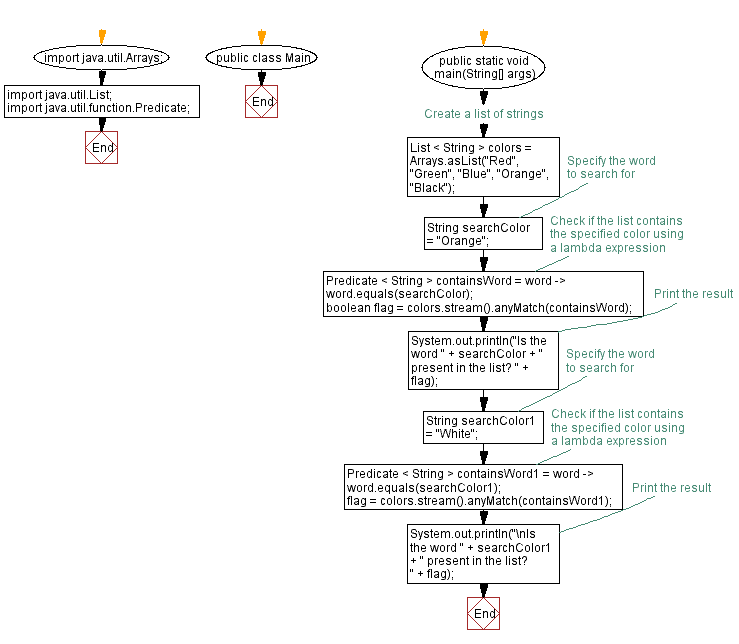Java program to check if a list contains a specific word using lambda expression
16. Check if word exists in list using lambda
Write a Java program to implement a lambda expression to check if a list of strings contains a specific word.
Sample Solution:
Java Code:
import java.util.Arrays;
import java.util.List;
import java.util.function.Predicate;
public class Main {
public static void main(String[] args) {
// Create a list of strings
List < String > colors = Arrays.asList("Red", "Green", "Blue", "Orange", "Black");
// Specify the word to search for
String searchColor = "Orange";
// Check if the list contains the specified color using a lambda expression
Predicate < String > containsWord = word -> word.equals(searchColor);
boolean flag = colors.stream().anyMatch(containsWord);
// Print the result
System.out.println("Is the word " + searchColor + " present in the list? " + flag);
// Specify the word to search for
String searchColor1 = "White";
// Check if the list contains the specified color using a lambda expression
Predicate < String > containsWord1 = word -> word.equals(searchColor1);
flag = colors.stream().anyMatch(containsWord1);
// Print the result
System.out.println("\nIs the word " + searchColor1 + " present in the list? " + flag);
}
}
Sample Output:
Is the word Orange present in the list? true Is the word White present in the list? false
Explanation:
In the above exercise -
- Import the necessary classes: Arrays, List, and Predicate.
- In the main method, we create a list of strings called colors using Arrays.asList().
- Specify the word we want to search for by assigning it to the variable searchColor.
- Define a lambda expression to check if a string equals the searchColor using the Predicate functional interface. The lambda expression compares each string with the searchColor using the equals() method.
- Use the stream() method on the colors list to create a stream of strings.
- Use the anyMatch() method along with the containsWord predicate to check if any element in the stream matches the predicate.
- The result of the anyMatch() operation is stored in the boolean variable flag.
Finally, we print the result, indicating whether the list contains the specified color.
Flowchart:

For more Practice: Solve these Related Problems:
- Write a Java program to implement a lambda expression that checks if any string in a list contains a given substring.
- Write a Java program to create a lambda that filters a list of strings by a specific keyword and returns the count.
- Write a Java program to implement a lambda expression that finds the first occurrence of a specific word in a list.
- Write a Java program to chain lambda expressions to search a list of strings for a word and then convert the result to uppercase.
Go to:
PREV : Sum squares of odd/even numbers using lambda.
NEXT : Find longest and shortest string using lambda.
Live Demo:
Java Code Editor:
Improve this sample solution and post your code through Disqus
What is the difficulty level of this exercise?
Test your Programming skills with w3resource's quiz.
